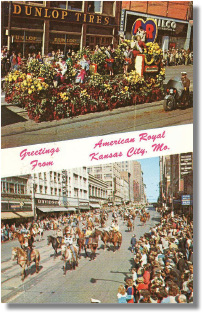
This photo-chrome postcard showing two scenes from the American Royal Parade was mailed on October of 1965 with a 4-cent, Abraham Lincoln stamp to Miss Agnes Julien, 822 E. Center Street, Salem, Mo., 65560.
The personal message on the back of the card reads: Dear Agnes, This is part of the parade – I didn’t see it, about the same each year. Too much trouble to get in to the crowd. I hope you haven’t been bitten by the flu bug. My sister is very ill at Norman Oklahoma so do not run around much. Certainly would like to see her, waiting to hear. Love, Agnes.
The roots of today’s American Royal can be traced to 1899 when the fledgling event was referred to as the National Hereford Show. Billed as the first nationwide show for the exposition and sale of purebred cattle, it was held during the month of October in a tent in the West Bottoms. The three-day sale drew close to 55,000 people and featured roughly 300 Herefords that were sold at auction for a little over $400 per head.
For several years after that first show, the annual event was held at a number of venues across Kansas City including Electric Park, Convention Hall and of course, the Stock Yards.
The original home of the American Royal was destroyed in a Valentine’s Day fire in 1925. It was rebuilt in time for the event that year and served as the center for events until the American Royal complex was built across from Kemper Arena in 1992. During World War II, the Royal complex was converted into a glider factory.
In 1926 the American Royal invited some local vocational agriculture students to judge the livestock show. During the 1928 American Royal, 33 of the students meeting at the Baltimore Hotel downtown formed what would later become the Future Farmers of America. The group grew exponentially and held their convention in Kansas City every year during the American Royal until 1998.
The description on the back of the card reads: Greetings from the American Royal. One of the highlights of the year in Kansas City is the American Royal. The beautiful American Royal float and the mounted horsemen are typical of the displays in the annual American Royal parade.


















